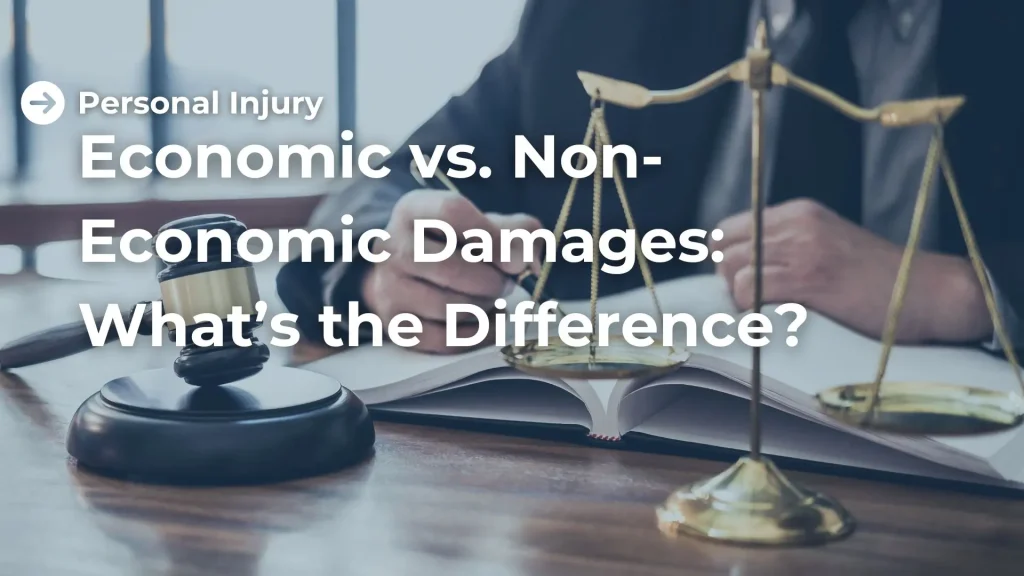
Are you coping with significant injuries, life-altering complications, stress, and financial instability? If so, the civil justice system offers an important path toward normalcy. The goal of any personal injury lawsuit is to help victims cope with the physical, financial, and emotional harms of an injury. As such, personal injury lawsuits can award a combination of economic and non-economic damages.
Damages are what the legal system calls monetary compensation. They can cover an individual’s financial losses after an accident as well as more subjective, intangible losses. Economic damages address the former, while non-economic damages address the latter. At Gibson Hill Personal Injury, our experienced Houston personal injury attorneys want to help untangle the confusion surrounding economic vs. non-economic damages, including what they are and how they get calculated. When you understand what’s on the line, you can better navigate your personal injury claim or lawsuit and fight for the money you deserve.
What Are Compensatory Damages in Texas?
There are different categories of damages in Texas personal injury cases, including compensatory and punitive damages. Punitive damages, or exemplary damages, are rare. They are not awarded to an accident victim to compensate for their financial losses or suffering. They are a monetary penalty the court can levy on a wrongdoer as a means of punishment for engaging in malicious or reckless behavior. The goal is also to prevent such behavior in the future. Texas law limits the recovery of punitive damages to $200,000 or two times the amount of non-economic damages up to $750,000, whichever is greater.
Compensatory damages compensate or reimburse an accident victim for the actual losses suffered because of the other party’s careless actions. There are two types of compensatory damages: economic and non-economic. What is the difference between economic and non-economic damages?
What Are Economic Damages?
Economic damages refer to a type of compensatory damage that compensates an accident victim for the money they’ve lost. Calculating economic damages is reasonably straightforward because they represent the actual dollar amounts. Examples of different types of economic damages include:
- Medical expenses – Medical expenses are one of the most common forms of economic damages. Most people are entitled to pursue compensation for current and future medical bills, medications, physical therapy, and rehabilitation costs.
- Lost wages – If you’ve experienced significant physical injuries following an accident, you know the recovery process can be long and challenging. Many people cannot work during this time, which means they lose wages every day they can’t work. In many cases, you can seek compensation for wages lost as a result of the accident.
- Loss of earning capacity – Catastrophic accidents can also cause disability, which may prevent an accident victim from being able to work in the same capacity as they did before the incident. Some people experience such serious injuries that they cannot return to work at all. Loss of future earning capacity accounts for the lost income you face if you cannot return to work or hold the same job as you did before the accident.
- Property damage – You may also pursue money for the loss of your personal property, including the vehicle cost of repairs or replacement.
It’s important to keep careful records of your medical expenses, property damage, and lost wages so you can provide clear evidence of the accident’s financial impact.
What Are Non-Economic Damages?
Non-economic damages are another form of compensatory damages. They should help accident victims with their recovery and any long-term, intangible impacts on their lives. They are a bit more complicated than their economic counterparts.
Non-economic damages are not always easy to identify or calculate. That’s because non-economic damages cover subjective quality-of-life changes, making it difficult to put a price tag. It is difficult, for example, to quantify human suffering or disfigurement. Some of the most common examples of non-economic damages you may pursue in Texas include:
- Pain and suffering – Pain and suffering refer to the physical and mental anguish you experience from the initial event and the overall recovery and treatment process.
- Loss of consortium – Pain, physical impairments, and suffering don’t just impact the accident victim. Family members also feel the negative impact of significant physical and mental injuries caused by an accident. Loss of consortium refers to the strain on family relationships due to significant injury. It typically impacts the spouse or children of the injured party and is the intangible loss or deterioration of a relationship.
- Emotional distress – Not all scars are skin deep. Some invisible scars leave a lasting impression on your mental health and wellness. Anxiety, depression, insomnia, and post-traumatic stress disorder are common after traumatic accidents, and the emotional distress you experience can negatively impact your overall health and quality of life.
- Loss of enjoyment of life – Health complications, disability, and disfigurement after an accident can reduce life enjoyment. Catastrophic accidents impact relationships, career, education, and hobbies.
Unlike some other states, Texas does not cap on non-economic damages, except in medical malpractice cases or cases involving government entities.
Calculating Non-Economic Damages
 The subjective nature of non-economic damages makes them difficult to quantify. Juries tend to have broad authority to decide on a number that seems fair to them. However, most successful personal injury claims never reach trial. Instead, insurance companies and injured claimants agree on a settlement that pays the claimant and releases the insurer from further liability. Insurers make their decisions based on what they think would likely happen in court. To that end, they employ formulas to help them estimate what a jury would likely award for non-economic damages.
The subjective nature of non-economic damages makes them difficult to quantify. Juries tend to have broad authority to decide on a number that seems fair to them. However, most successful personal injury claims never reach trial. Instead, insurance companies and injured claimants agree on a settlement that pays the claimant and releases the insurer from further liability. Insurers make their decisions based on what they think would likely happen in court. To that end, they employ formulas to help them estimate what a jury would likely award for non-economic damages.
Don’t let an insurance company tell you how much your pain and suffering is worth. Instead, get help from an experienced personal injury lawyer. They can get to know and understand the toll your injuries have taken on your life and demand a settlement figure that fairly addresses the harm you’ve endured.
Let Our Texas Personal Injury Lawyers Help You
At Gibson Hill Personal Injury, we are committed to helping you recover maximum compensation for your injuries and financial losses following an accident caused by the negligence or recklessness of another person. Contact our law firm today at 713-659-4000 or through our online form to request your free consultation. Learn more about your legal rights.




